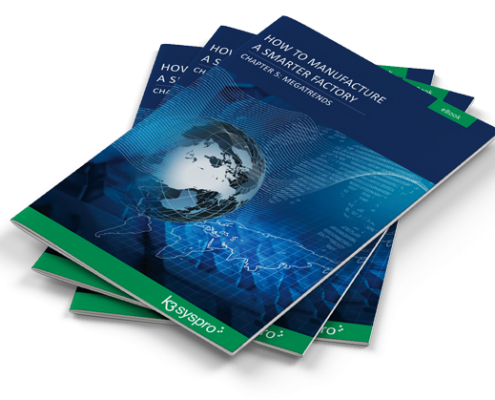
Digital Supply Chain - Are You Ready?
We discuss how you'll know if you are ready to take the next steps and become Digital Supply Chain ready. It is not only the OEMs and Tier 1s who should be benchmarking their progress.

Digital Supply Chain - Navigating the Technology Landscape
We look at the important terms, phrases and technologies you need to understand if your company is to be ready for Digital Supply Chain Networks.

Digital Supply Chain - What is a Digital Supply Chain
We discuss what we actually mean by "Digital Supply Chain" and how they are going to change business process in the manufacturing and engineering sectors.

Industry 4.0 - How to Manufacture a Smarter Factory
With this eBook we aim to reveal some of the small steps that you can take in your manufacturing business to better utilise your ERP solution, revolutionise your business model, and catapult your company ever closer towards Industry 4.0.

Industry 4.0 chapter 5 - Megatrends
In this chapter we’ll be covering the megatrends that could help keep your business competitive for the foreseeable future and will retain relevance with your customers. Our top tips include tying megatrend research and analysis into your strategic review and keeping an eye on the competition’s approach to megatrends. A meaty but easy to digest set of bullet points will cover a variety of megatrends in practice while our leading practice inspiration will again come from Industry 4.0 powerhouse, Rolls-Royce.

Industry 4.0 chapter 4 - Robots and Automation
Robotics and automation products are more affordable now than ever before and are a staple of Industry 4.0. We’ll cover the jobs that are created, not lost, as a result of automation and how robots boost productivity, competitiveness and therefore overall margins. Our top tips include: thinking where robots integrate into your existing technology and focusing on added value not cost reduction. K3 customer BPW. Civil aircraft engineers, Airbus are world
leaders in robots and focus of our leading practice, going as far as experiments with wearable robots.

Industry 4.0 chapter 3 - Big Data Analysis
Big Data analytics is the process of examining large data sets to uncover patterns, correlations, market trends and various useful business information that had previously been hidden. This chapter will provide some top tips on implementing Big Data into your business, which in turn will provide all the information you’ll need to improve areas of value for your customers. We’ll look into how healthcare and consumer goods manufacturer (and fellow Salfordians), PZ Cussons, make the most of the data extracted from their SYSPRO ERP solution. General Electric will be the subject of our Big Data leading practice, we’ll look into how GE reduced total cost of ownership of their products for customers with GE reducing margins and also pass energy saving advice onto their customers.

Industry 4.0 Chapter 2 - Supply Chain Integration
Integrating the supply chain is critical to the success of a manufacturers if they want to be part of the fourth industrial revolution. In this chapter we will cover the benefits of an integrated supply chain, such as reduced costs, and also a few tips on successfully integrating your supply chain. K3 customer and world leading axle supplier, BPW, provide our case study for how K3 are helping UK manufacturers integrate the supply chain. While our leading practice looks into how global computer technology company, Dell, integrated its suppliers into the ordering process for a seamless configure to order approach.

Industry 4.0 Chapter 1 - The Future of Manufacturing
In this chapter we address ‘servitization’ and the benefits it can bring. The days of ‘point of sale’ being the last contact a manufacturer has with their
product are becoming a thing of the past. Servitization is allowing manufacturers and their customers to not only build a more effective product but a stronger relationship too! This is exactly what K3 customer, G&B Electronics, and business services and document technology products provider, Xerox, are doing. We’ll take a look into how both companies are embracing a servitized business model to remain relevant within their market.


